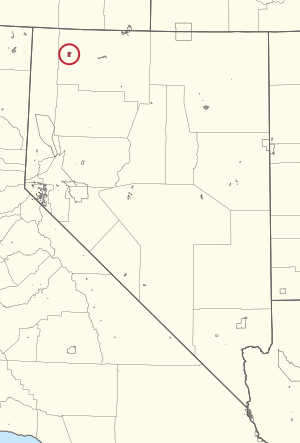Summit Lake Paiute Tribe of Nevada facts for kids
| Agai Panina Ticutta | |
|---|---|

Sign at Summit Lake Indian Reservation
|
|
| Total population | |
| 120 | |
| Regions with significant populations | |
| Languages | |
| Northern Paiute, English | |
| Religion | |
| Indigenous, Christianity |
The Summit Lake Paiute Tribe of Nevada is a Native American tribe. They are part of the Northern Paiute group. This tribe is officially recognized by the United States government. They live in northwest Nevada.
In their own language, they call themselves Agai Panina Ticutta. This means "Fish Lake Eaters." People have traditionally known them as the "Fish Eaters."
The Summit Lake Paiute Tribe has its own special land called the Summit Lake Indian Reservation. This reservation is in Humboldt County, Nevada, at 41°31′27″N 119°03′08″W / 41.52417°N 119.05222°W. It was created in 1913. The reservation covers about 12,573 acres (50.88 square kilometers). A large part of this land, about 10,098 acres (40.87 square kilometers), is held in trust for the tribe. This means the government holds the land for the tribe's benefit. The tribe's land is in a very remote part of Nevada. It is one of the most isolated tribes in the state.
In 2016, a new law was passed. This law added about 941 acres (3.81 square kilometers) of land to the tribe's reservation. This new land is held in trust for the tribe. It was added under a law called the Nevada Native Nations Land Act. The tribe cannot use these new lands for gambling businesses.
Contents
What is the Summit Lake Indian Reservation?
The Summit Lake Indian Reservation is the special land set aside for the Summit Lake Paiute Tribe. It is located in Humboldt County, Nevada. The exact location is 41°31′27″N 119°03′08″W / 41.52417°N 119.05222°W.
The reservation was officially created in 1913. It covers about 12,573 acres (50.88 square kilometers). About 10,098 acres (40.87 square kilometers) of this land are "trust lands." This means the land is owned by the U.S. government but held for the tribe's use.
In 1990, only 6 tribal members lived on the reservation. By 1992, there were 112 people officially part of the tribe. Summit Lake itself is part of the reservation. However, there is no safe drinking water source directly on the reservation.
How the Reservation Land Grew
In October 2016, a law called the Nevada Native Nations Land Act was passed. This law helps several tribes in Nevada get more land. It allows the Department of Interior to put land into trust for them. For the Summit Lake Paiute Tribe, this law added about 941 acres (3.81 square kilometers) of land to their reservation. This new land cannot be used for gambling.
History of the Summit Lake Paiute Tribe
Before Europeans came to America, the Agai Panina Ticutta people lived in a large area. This area was about 2,800 square miles (7,300 square kilometers). It was located where Nevada, California, and Oregon meet today. Other Paiute, Shoshone, and Bannock tribes also lived in Nevada and southwestern Oregon.
Changes After the American Civil War
After the American Civil War, the United States government took control of these lands. In 1867, part of their land became a military base called Camp McGerry. The military left this camp in 1871. The buildings that were left at Camp McGerry now belong to the tribe.
Challenges for Children's Education
During the late 1800s and early 1900s, Native American children in Nevada were not allowed to go to public schools. The federal government made tribal children attend special boarding schools. These schools were in places like Fort Bidwell, California; Stewart, Nevada; and the Sherman Institute in Riverside, California.
These schools tried to make Native American children live like the majority culture. They had to speak English and were mixed with children from many different tribes. To keep their families together, many tribal members moved away from the reservation. They often joined Native American communities on the edges of cities. There, parents could find work. Some of these communities, like the Reno-Sparks Indian Colony, are now officially recognized as tribes by the government.
When the Reservation Was Created
The current tribal reservation was officially created on January 14, 1913. President Woodrow Wilson signed an Executive Order (number 1681) to set aside 5,026 acres (20.34 square kilometers) of land in trust for the tribe.
Forming a New Government
On October 24, 1964, the Agai Panina Ticutta Tribe decided to change their government. They voted to stop using their traditional system with hereditary chiefs. Instead, they created a new elected government. This was done under the 1934 Indian Reorganization Act. After this, the tribe was officially recognized by the federal government as the Summit Lake Paiute Tribe on January 8, 1965.
The Summit Lake Paiute Tribe Today
The main office for the Summit Lake Paiute Tribe is in Sparks, Nevada. They have a special "government-to-government" relationship with the U.S. federal government. This means they work together on important issues.
Currently, about 120 people are officially part of the tribe. A very important goal for the tribe is to protect their natural resources and the environment. People who are not tribal members are not allowed to hunt or fish on the reservation.
How the Tribe is Governed
The tribe is led by an elected Tribal Council. This council has five members, including a chairperson. They are elected for three-year terms.
The Tribal Council members from 2009-2012 were:
- Chairwoman: Randi Lone Eagle
- Vice-Chairperson: Nedra Crane
- Secretary/Treasurer: Eugene Mace Sr.
- Member: Steven Crane
- Member: Philip Frank


